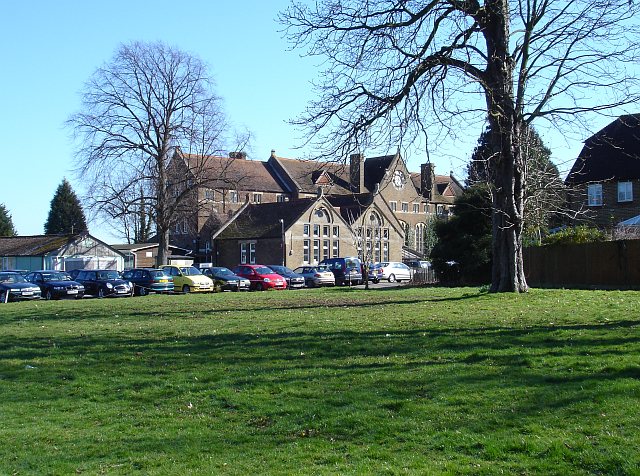|
Borden, Kent
Borden is a village and electoral ward situated immediately south west of Sittingbourne, Kent, from which it is separated by a small area of rural land. The history of the name could be questioned. It may be derived from bor (hill) and then either from denu (valley) or denn (woodland pasture). It may also derive from "boar" "den", as it was known that the wild animals were found in the surrounding areas. Borden was first recorded in the twelfth century as Bordena. However it is more likely to stem from Sir Francis de Bourdon,(variations today also include Borden/Burden/Bourdon) who descended from the de Bourdons of Bayeux, in Normandy, France. Francis de Bourdon became Lord of the existing castle and surrounding lands, granted to him by William the Conqueror, as a gift to his vassal after the great Norman victory in 1066, and at which time became known as Bourdon. The lands were previously lorded over by the Saxon Ethelwolf of Kent, who perished at the Battle of Hastings (1066) ... [...More Info...] [...Related Items...] OR: [Wikipedia] [Google] [Baidu] |
Borough Of Swale
Swale is a local government district with borough status in Kent, England and is bounded by Medway to the west, Canterbury to the east, Ashford to the south and Maidstone to the south west. Its council is based in Sittingbourne. The district is named after the narrow channel called The Swale, that separates the mainland of Kent from the Isle of Sheppey, and which occupies the central part of the district. The district was formed in 1974 under the Local Government Act 1972, from the Borough of Faversham; the Borough of Queenborough-in-Sheppey, which covered the whole of Sheppey; the Sittingbourne and Milton Urban District; and Swale Rural District. Most of the southern half of the Borough lies within the Kent Downs Area of Outstanding Natural Beauty, whilst Sittingbourne and the Isle of Sheppey forms the concluding part of the Thames Gateway growth area. There are four towns in the borough: Sittingbourne and Faversham on the mainland, and Sheerness and Queenborough on S ... [...More Info...] [...Related Items...] OR: [Wikipedia] [Google] [Baidu] |
Agriculture
Agriculture or farming is the practice of cultivating plants and livestock. Agriculture was the key development in the rise of sedentary human civilization, whereby farming of domesticated species created food surpluses that enabled people to live in cities. The history of agriculture began thousands of years ago. After gathering wild grains beginning at least 105,000 years ago, nascent farmers began to plant them around 11,500 years ago. Sheep, goats, pigs and cattle were domesticated over 10,000 years ago. Plants were independently cultivated in at least 11 regions of the world. Industrial agriculture based on large-scale monoculture in the twentieth century came to dominate agricultural output, though about 2 billion people still depended on subsistence agriculture. The major agricultural products can be broadly grouped into foods, fibers, fuels, and raw materials (such as rubber). Food classes include cereals (grains), vegetables, fruits, cooking oils, meat, milk, ... [...More Info...] [...Related Items...] OR: [Wikipedia] [Google] [Baidu] |
Populated Places Established In The 11th Century
Population typically refers to the number of people in a single area, whether it be a city or town, region, country, continent, or the world. Governments typically quantify the size of the resident population within their jurisdiction using a census, a process of collecting, analysing, compiling, and publishing data regarding a population. Perspectives of various disciplines Social sciences In sociology and population geography, population refers to a group of human beings with some predefined criterion in common, such as location, race, ethnicity, nationality Nationality is a legal identification of a person in international law, establishing the person as a subject, a ''national'', of a sovereign state. It affords the state jurisdiction over the person and affords the person the protection of the ..., or religion. Demography is a social science which entails the statistical study of populations. Ecology In ecology, a population is a group of organisms of the ... [...More Info...] [...Related Items...] OR: [Wikipedia] [Google] [Baidu] |
1066 Establishments In England
1 (one, unit, unity) is a number representing a single or the only entity. 1 is also a numerical digit and represents a single unit of counting or measurement. For example, a line segment of ''unit length'' is a line segment of length 1. In conventions of sign where zero is considered neither positive nor negative, 1 is the first and smallest positive integer. It is also sometimes considered the first of the infinite sequence of natural numbers, followed by 2, although by other definitions 1 is the second natural number, following 0. The fundamental mathematical property of 1 is to be a multiplicative identity, meaning that any number multiplied by 1 equals the same number. Most if not all properties of 1 can be deduced from this. In advanced mathematics, a multiplicative identity is often denoted 1, even if it is not a number. 1 is by convention not considered a prime number; this was not universally accepted until the mid-20th century. Additionally, 1 is ... [...More Info...] [...Related Items...] OR: [Wikipedia] [Google] [Baidu] |
Borden Grammar School
Borden Grammar School is a grammar school with academy status in Sittingbourne, Kent, England, which educates boys aged 11–18. A small number of girls have also been admitted to the Sixth Form. The school holds specialist status in sports. History Plans for a boys' school in Borden began in 1875, as a new way of using some of the accumulated funds from the Barrow Trust, established from the estate of William Barrow (d. 1707), a local farmer, for the benefit of the poorer inhabitants of the village. The trustees of the Barrow Trust became the new school's governors, and they began organising a suitable sum of money to allow the project to go ahead. Within a few years, they had amassed £9,500 and the building of the school began on a seven-acre site in Riddles Road, which belonged to the trust. The Barrow Boys' School, Borden, was to be an independent day and boarding school, designed to have some fifty boarders and some 150 day pupils. The school formally opened in October ... [...More Info...] [...Related Items...] OR: [Wikipedia] [Google] [Baidu] |
Violet McNaughton (activist)
Violet Clara McNaughton (born Violet Clara Jackson; November 11, 1879 – February 3, 1968) was a Canadian journalist and agrarian feminist notable for co-establishing ''The Western Producer'' and contributing to its "Mainly for Women" pages from 1925 until her retirement in 1950. A settler and farmer of Harris, Saskatchewan (land of the Plains Cree), she was an active member of the Women's Section of the Canadian Council of Agriculture as well as the first president of the Women Grain Growers (WGG), a branch of the Saskatchewan Grain Growers Association (SGGA). McNaughton is considered the leader of women's suffrage in Saskatchewan and is recognized as the most influential Canadian farm woman of the 20th century.Taylor, Georgina M. "McNaughton, Violet Clara (1879- 1968)." ''The Encyclopedia of Saskatchewan , Details'', https://esask.uregina.ca/entry/mcnaughton_violet_clara_1879-_1968.jsp . McNaughton was a known pacifist and supporter of women's suffrage and Opposition to Worl ... [...More Info...] [...Related Items...] OR: [Wikipedia] [Google] [Baidu] |
Robert Plot
Robert Plot (13 December 1640 – 30 April 1696) was an English naturalist, first Professor of Chemistry at the University of Oxford, and the first keeper of the Ashmolean Museum. Early life and education Born in Borden, Kent to parents Robert Plot and Elisabeth Patenden, and baptised on 13 December 1640, Plot was educated at the Wye Free School in Kent. He entered Magdalen Hall, Oxford in 1658 where he graduated with a BA in 1661 and an MA in 1664. Plot subsequently taught and served as dean and vice principal at Magdalen Hall while preparing for his BCL and DCL, which he received in 1671 before moving to University College in 1676.A. J. Turner, 'Plot, Robert (bap. 1640, d. 1696)', Oxford Dictionary of National Biography, Oxford University Press, 200accessed 4 June 2013/ref>Plot, Robert." Complete Dictionary of Scientific Biography. Vol. 11. Detroit: Charles Scribner's Sons, 2008. 40–41. Gale Virtual Reference Library. Web. 4 June 2013. Natural history and chemistry By ... [...More Info...] [...Related Items...] OR: [Wikipedia] [Google] [Baidu] |
Electoral Ward
A ward is a local authority area, typically used for electoral purposes. In some countries, wards are usually named after neighbourhoods, thoroughfares, parishes, landmarks, geographical features and in some cases historical figures connected to the area (e.g. William Morris Ward in the London Borough of Waltham Forest, England). It is common in the United States for wards to simply be numbered. Origins The word “ward”, for an electoral subdivision, appears to have originated in the Wards of the City of London, where gatherings for each ward known as “wardmotes” have taken place since the 12th century. The word was much later applied to divisions of other cities and towns in England and Wales and Ireland. In parts of northern England, a ''ward'' was an administrative subdivision of a historic counties of England, county, very similar to a hundred (country subdivision), hundred in other parts of England. Present day In Australia, Canada, New Zealand, Sri Lanka, South Afr ... [...More Info...] [...Related Items...] OR: [Wikipedia] [Google] [Baidu] |
Ironmonger
Ironmongery originally referred, first, to the manufacture of iron goods and, second, to the place of sale of such items for domestic rather than industrial use. In both contexts, the term has expanded to include items made of steel, aluminium, brass, or other metals, as well as plastics. The term ironmonger as a supplier of consumer goods is still widely used in Great Britain, the US equivalent being "hardware store". Many architectural ironmongery items (for example, door handles, locks, hinges, etc.) are also manufactured for wholesale and commercial use in offices and other buildings. History Dealing in ironware has a long tradition, dating back to the first recorded use of the metal to fashion useful objects as long ago as 1200 BC, and studying the movement of such goods around the world, often over long distances, has provided valuable insight into early societies and trading patterns. By the Middle Ages, skilled metalworkers were highly prized for their ability to crea ... [...More Info...] [...Related Items...] OR: [Wikipedia] [Google] [Baidu] |
Bellfounding
Bellfounding is the casting and tuning of large bronze bells in a foundry for use such as in churches, clock towers and public buildings, either to signify the time or an event, or as a musical carillon or chime. Large bells are made by casting bell metal in moulds designed for their intended musical pitches. Further fine tuning is then performed using a lathe to shave metal from the bell to produce a distinctive bell tone by sounding the correct musical harmonics. Bellfounding in East Asia dates from about 2000 BCE and in Europe from the 4th or 5th century CE. In Britain, archaeological excavations have revealed traces of furnaces, showing that bells were often cast on site in pits in a church or its grounds. Centralised foundries became common when railways allowed easy transportation of bells, leading to the dominance of founders such as the Whitechapel Bell Foundry and John Taylor & Co of Loughborough. Elsewhere in the world a number of foundries are still activ ... [...More Info...] [...Related Items...] OR: [Wikipedia] [Google] [Baidu] |
Cherry
A cherry is the fruit of many plants of the genus ''Prunus'', and is a fleshy drupe (stone fruit). Commercial cherries are obtained from cultivars of several species, such as the sweet ''Prunus avium'' and the sour ''Prunus cerasus''. The name 'cherry' also refers to the cherry tree and its wood, and is sometimes applied to almonds and visually similar flowering trees in the genus ''Prunus'', as in " ornamental cherry" or "cherry blossom". Wild cherry may refer to any of the cherry species growing outside cultivation, although ''Prunus avium'' is often referred to specifically by the name "wild cherry" in the British Isles. Botany True cherries ''Prunus'' subg. ''Cerasus'' contains species that are typically called cherries. They are known as true cherries and distinguished by having a single winter bud per axil, by having the flowers in small corymbs or umbels of several together (occasionally solitary, e.g. ''P. serrula''; some species with short racemes, e.g. '' P. ... [...More Info...] [...Related Items...] OR: [Wikipedia] [Google] [Baidu] |
Oad Street
Oad Street is a small hamlet in the English county of Kent. Oad Street forms part of the civil parish of Borden which, in turn, is part of Swale district. Oad Street is located close to Junction 5 of the M2 motorway where it crosses the A249 road. History In 1798, Edward Hasted records that this hamlet was once called Hoade Street and Woodstreet, before becoming Oade Street. Named after a nearby Chestnut Wood (which covered the hillside down towards Danaway). In 1653, most of the parish was controlled by William Genery (from Throwley). Buildings In the hamlet are 3 listed buildings, Grade II* listed 'Yew Tree Cottage', Grade II listed 'The Olde House', and Grade II listed 'Hoad House'. Also a local public house, the 'Plough & Harrow' public house. It also had a former Wesleyan Wesleyan theology, otherwise known as Wesleyan– Arminian theology, or Methodist theology, is a theological tradition in Protestant Christianity based upon the ministry of the 18th-century evan ... [...More Info...] [...Related Items...] OR: [Wikipedia] [Google] [Baidu] |









.jpg)